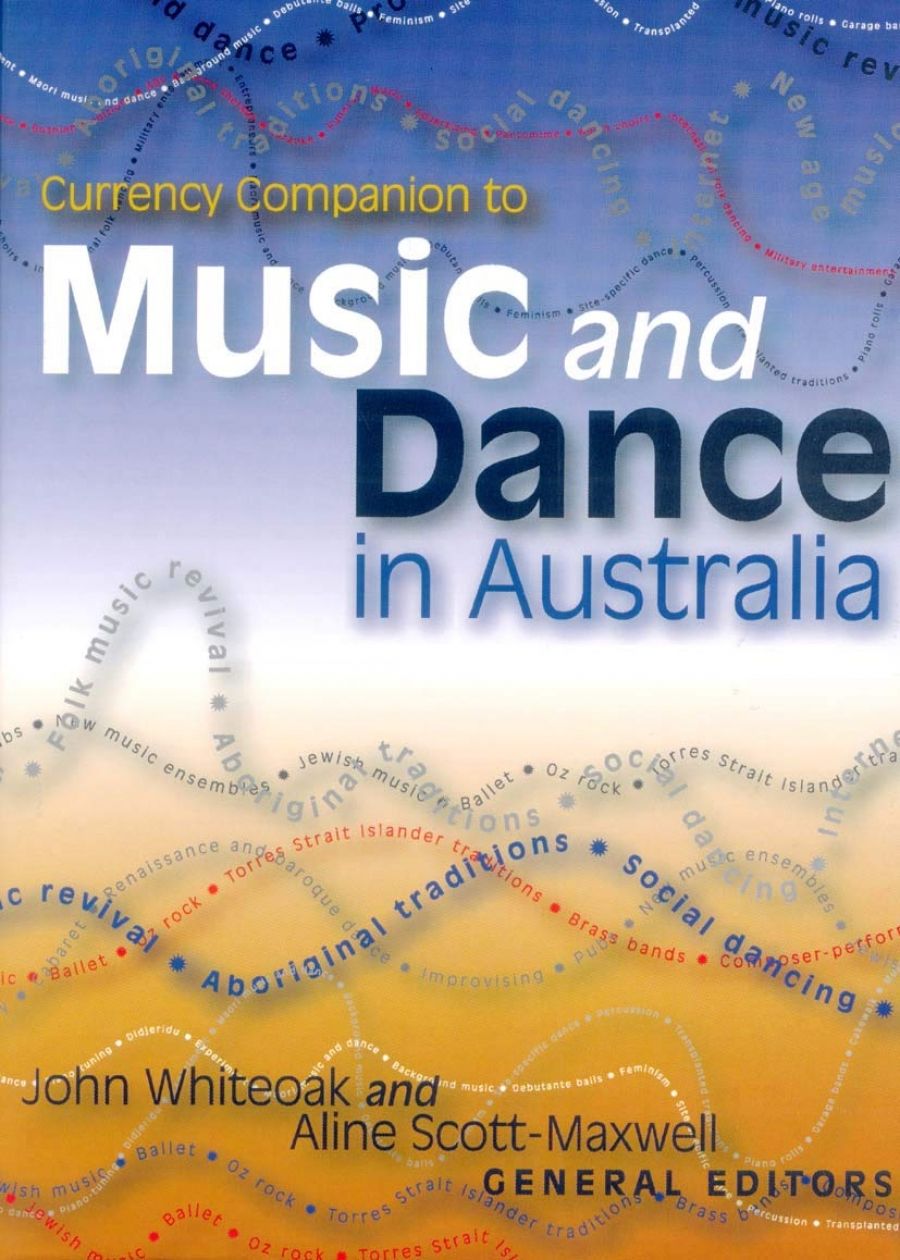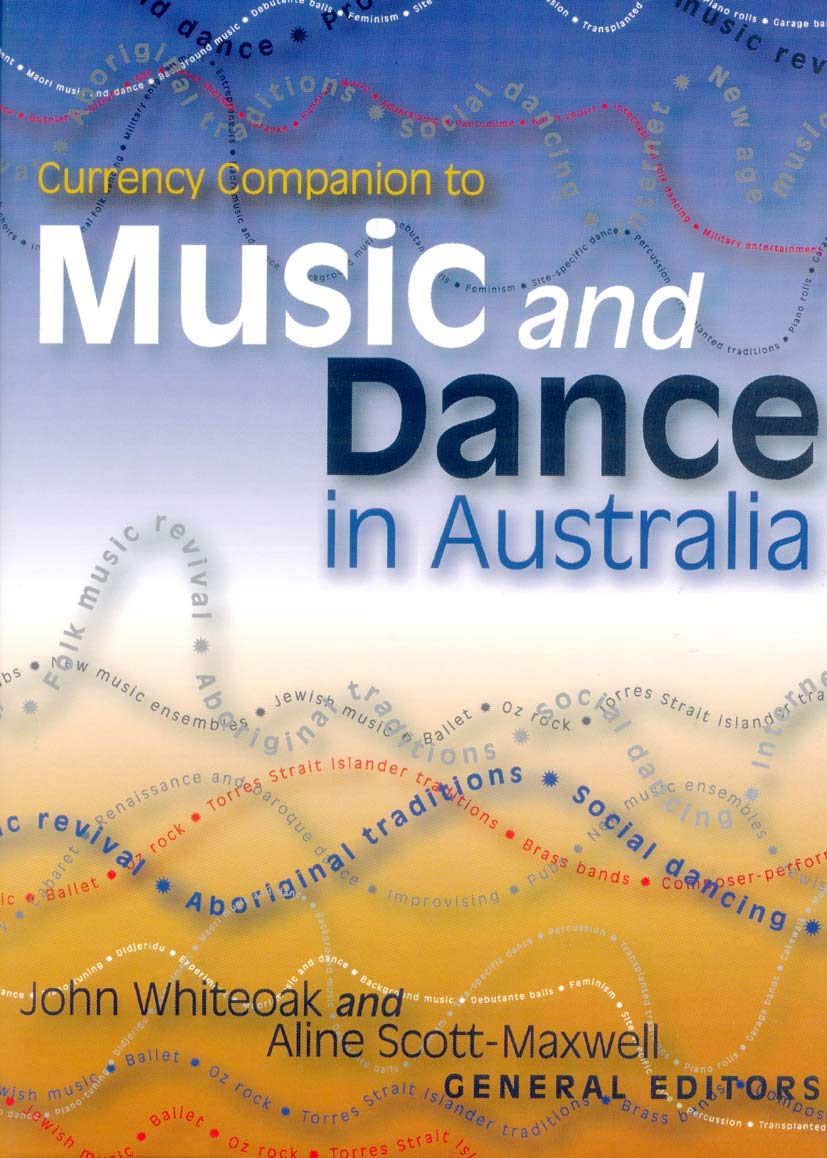
- Free Article: No
- Contents Category: Australian History
- Review Article: Yes
- Article Title: Up There Cow Punk
- Online Only: No
- Custom Highlight Text:
This hefty volume begins with an article on a cappella singing (ensembles with names like Café of the Gate of Salvation and Voices from the Vacant Lot) and ends with the zither, which instrument, the editors assure us, ‘can be seen as a metaphor for the present-day cultural diversity of music in Australia’. We have no lack of companions today: indeed, over the last decade they have been coming thick and fast. However the Currency Companion to Music and Dance in Australia seems to have had a particularly troubled genesis, though the editors, John Whiteoak and Aline Scott-Maxwell, make no reference to it.
- Book 1 Title: Currency Companion to Music and Dance in Australia
- Book 1 Biblio: Currency House, $120hb, 734pp
- Book 1 Cover Small (400 x 600):

- Book 1 Cover (800 x 1200):

The emphasis in the Currency Companion is on ‘music and dance as practice, activity or process’. There are the substantial articles you would expect on Ballet, Jazz, Modern Dance, Opera and Popular Music, the longest, perhaps not surprisingly, being on Composing Music. But there is also a twelve-page survey of Aboriginal Traditions and major articles on Brass Bands, Choreography, Church Music and Social Dancing. The playing of musical instruments, from the piano to the tin whistle and wobbleboard, attracts articles long and short; David Kinsela, for example, contributes comprehensive pieces on Organ-Building and Organ-playing. The article on the didgeridoo even breaks the rules by including an extract from an interview with the noted Arnhem Land master-maker and player, David Blanasi, who has since died. The most notable omission among instruments is the human voice: although there are articles on Choral Music and Yodelling, singing itself – and singing teachers – escapes the editors’ net. Crooning, for example, gets only passing mention in the context of Amplified Sound and Jazz.
This companion is conscientiously multicultural, with articles on a wide range of ethnic communities and influences, though somehow, while the Portuguese get in, the Spanish miss out. Estonian and Ethiopian traditions rub shoulders in the text, and you can learn about the local popularity of Ukrainian-language versions of Viennese operettas (that merry widow is clearly a great traveller), while over the page being introduced to the mysteries of the Vietnamese unicorn dance.
In opting for ‘practice, activity or process’, the editors decided that there would be no biographical articles. If the companion is meant to be a comprehensive and useful work of reference, this strikes me as being remarkably perverse; one is even tempted to suspect an element of the tall poppy syndrome. For biographical information, one is told to use the index, but this can be an exhausting process (no pun intended), particularly if there are a number of references, many of which may be merely the most passing of mentions. And in preferring process to people, the result is that a distinguished soprano such as Florence Austral is only fleetingly present as a member of a 1934 opera company, while Marie Collier is ignored entirely. Another notable absentee is Madge Elliott, whose career covered both dance and musical theatre, but who doesn’t conveniently fit into the narratives of those articles. One suspects that an unspoken consideration in determining the editors’ policy was to distinguish this companion from its Oxford predecessor, in which you will find, for example, articles on Austral, Elliott and Collier.
This raises the question of the extent to which a work of reference such as this is meant to stand alone or, alternatively, might acknowledge the possible usefulness of other such works. It may be asking too much to expect the editors to direct you to the The Oxford Companion to Australian Music for biographical articles relating to music – dancers, alas, missing out entirely – but it is curious that we are not reminded of the overlaps with other Currency volumes. Elliott rates an article in Currency’s Companion to Theatre in Australia (1995) – and, be it noted, along with her husband and partner Cyril Ritchard, both the Australian Dictionary of Biography and the forthcoming British New Dictionary of National Biography. Katharine Brisbane’s Entertaining Australia: The Performing Arts as Cultural History (1991) provides a useful complementary source for the performance of music and dance: it has, for example, six references to Austral, including a photograph. Whiteoak and Scott-Maxwell absolve their consciences by listing other works of reference in a bibliography buried in an article on Research and Writing, a clue to this being offered in the introductory note, ‘How this book works’, with a casual reference to locating ‘Australian reference works, such as Bruce Johnson’s Oxford Companion to Australian Jazz [1987]’.
Cross-referencing within the volume is also less than perfect. The article on Musical Theatre does not refer you to the separate article on Gilbert and Sullivan, though the latter gives the reverse reference. Writing on ballet, Michelle Potter makes passing mention of the historic 1981 strike by dancers of the Australian Ballet, but there is no cross-reference to the much fuller account offered by Helen Penrose under Industrial Relations.
There are, therefore, pluses and minuses to the Currency Companion. Its strength lies in the breadth and diversity of articles. A composite article on Gender, for example, takes one from the implications of ‘men in bulging tights’ to women in dance bands. (It is cross-referenced to Feminism, but not to the article on Queer Performance.) Among the more esoteric, not to say way-out, genres accorded recognition my favourite is Cow Punk, also known as pyschobilly and country grunge, which apparently enjoyed a minor vogue in the 1980s. Melbourne boasted bands with names such as the Corpse Grinders and Crushed Buzzards, and the lyrics of their songs, Bronius Zumeris dutifully informs us, dealt energetically with subjects such as suicide, psychosis, werewolves and Dr Frankenstein’s monster. One appreciates, too, the poker-faced seriousness with which Whiteoak – who, incidentally, contributes innumerable articles – likens the football song ‘Up There Cazaly’ to ‘an ode to a supreme being’.
Although the editors seek to bypass muddy issues of Australianness, they cannot be avoided altogether. ‘Waltzing Matilda’ is accorded the unusual honour of a short article, while to hunt down the national anthem, ‘Advance Australia Fair’, you have to resort to the index. That is a comment in itself. Kinsela suggests that organ-playing, ‘being peculiarly athletic ... has appeal to the Australian temperament’, but, interestingly, Peter Campbell, writing about Choral Singing, doesn’t take up Roger Covell’s old hypothesis that the choir, as a cultural institution that appointed its own conductor, suited the mentalité of colonial democracy. In their article on Modern Dance, Valda Craig and Garry Lester plausibly argue that now, as a people, we are more relaxed and self-assured, Australianness in dance ‘is sometimes evident in nothing more than an openness and boldness of movement’. On the other hand, I think Josephine Fantasia and Whiteoak are unfair in dismissing the failure at the box office of Manning Clark’s History of Australia – The Musical as no more than evidence that ‘Australian audiences had outgrown bluntly nationalistic musicals’. This ignores the considerable controversy the production stimulated and the passionate commitment of the cast to keeping the show on.
As a footnote, I offer the tantalising information that the popular songwriter, Jack O’Hagan, who gave us ‘Along the road to Gundagai’, cross-dressed, so to speak, sometimes writing under the pseudonym of Pamela Therese. Perhaps there’s a little bit of Pamela Therese in all of us!


Comments powered by CComment